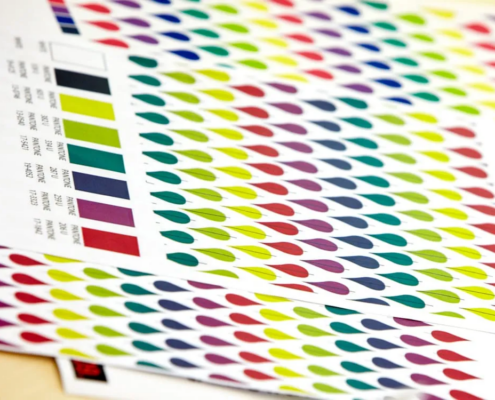Printing brings a high added value to tissue products. For printing, this also means a new profit growth point, which deserves to draw attention to.
Printing Ink

PANTONG
For napkin products, direct and close contact with human body, such as mouth, hands or eyes and food, hygiene and environmental protection are very important. The current water-based ink used in tissue flexographic printing presses is environmentally friendly, non-polluting, odorless and fully compliant with hygiene and environmental protection requirements. In addition, many domestic consumers when it comes to color napkins, will coincidentally raise such a concern, that is, the use of such colorful tissue paper, the printing of ink will not stain the skin, or pollution of the surrounding environment. In fact, this worry is not necessary, tissue printing factory in the choice of ink has been fully considered these, especially the ink wear resistance, water resistance, blot resistance, etc. are very important technical indicators for tissue printing ink to be repeated skin contact test and wear resistance, blot resistance test, especially in home life may have many easy to induce ink blotting substances, therefore, compared to ordinary water-based Therefore, compared to ordinary water-based inks, the tissue printing ink formula also adds certain ingredients that can effectively prevent the ink printed on the tissue from blotting or dissolving when in contact with water or strong alkaline substances.
Printing Equipment
The tissue flexo printing machine is designed with laminated or satellite structure, and the whole machine includes unrolling, printing and inline processing parts. The entire process is fully automated, starting from unwinding, through printing, folding, embossing, fragrance addition and counting to the finished tissue paper. The flexographic printing equipment is of a combined design and is quite flexible in terms of configuration. All units, including the number of printing units, can be increased or decreased, and printers can tailor the machine to meet their business needs.
Tissue flexographic printing machine is characterized by high speed and high output, taking our company’s tissue flexographic printing machine as an example, the width is 500 – 2740mm, printing speed can reach 600 – 700m/min; printing unit can be up to The printing unit can be configured to a maximum of 8 color groups; in the paper output section, there are several paper collection methods such as single paper path, double paper path and even 8 paper path, depending on the size of the output.
In the tissue printing process, due to the special nature of the tissue material, the control of printing tension is one of the key factors affecting the quality of the printed product. Many high-end flexographic printing equipment have adopted shaftless drive technology, in the unwinding, printing, ginning, folding and other units using independent DC motor control, and with digital control of multiple floating rollers and paper clamping rollers, making the equipment tension control and register control effect has been greatly improved. Secondly, the drying performance of the equipment is also very important, tissue flexo printing presses mostly use infrared, hot air or a combination of the two drying methods, and with water-cooled cylinder program, so it can achieve a better drying effect and meet the requirements of the product.
However, there is a problem in tissue printing, because the tissue material itself more paper hair, poor surface strength, easy to fall off powder, hair, adhering to the printing plate and gradually accumulate, it will cause dirty and blocked plate, must stop cleaning. In response to this annoying problem, many manufacturers install vacuum devices in the printing unit to solve it, or with special squeegees can also reduce the incidence of such problems.
Post-processing is a very important part of the tissue flexo printing, to fold tissue paper for example, the folding of tissue paper is very delicate, requiring square edges and sharp corners, in this process, tension control is particularly critical. Tissue is folded in a variety of flexible ways.
Embossing is also a very important part of the tissue production process. Embossing can improve the softness and moisture absorption of the tissue, while the different patterns of embossing also add to the aesthetic effect. There are various ways of embossing, such as point to point, steel to steel, steel to paper, steel to rubber, etc. It can also be divided into partial embossing and total embossing.
GET IN TOUCH

